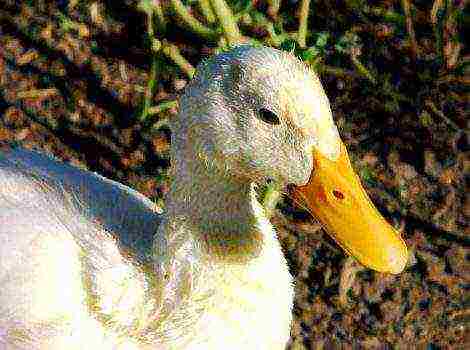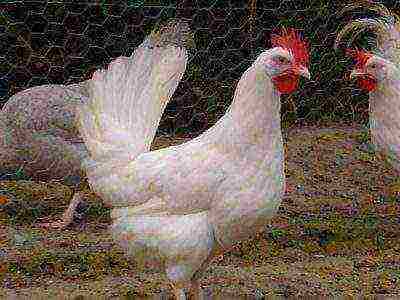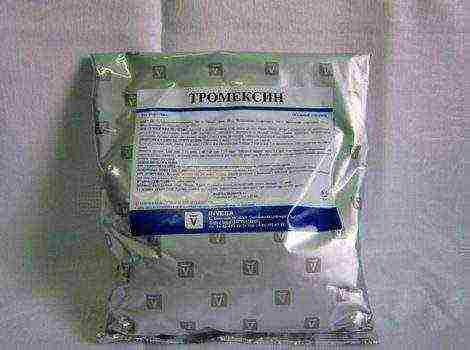Content
- 1 Breeding quail at home
- 1.1 Where did it all begin
- 1.2 Varieties and their characteristics
- 1.3 Incubation of eggs
- 1.4 Feeding quail at home
- 1.5 Feeding adult quails
- 1.6 Feeding birds for meat
- 1.7 Features of winter cultivation
- 1.8 Quail diseases
- 1.9 Quail reviews from breeders
Breeding quail at home
Breeding and raising quails at home is not the last place in the farm. The bird has gained its popularity thanks to its delicious and healthy eggs. But quail is bred not only for this reason. Many breeders keep them for the dietary delicious meat for which many breeds of poultry are famous.
Where did it all begin
Common quail is a small bird pheasant family, the smallest representative of the chicken order. Its body length is only 20 cm, and the weight of an adult is from 80 to 150 grams.
Feather color common quail beige with spots and strokes. Males have a darker color of the goiter, and around the eyes there is a pronounced dark spot that looks like a helmet. Females do not have these spots.
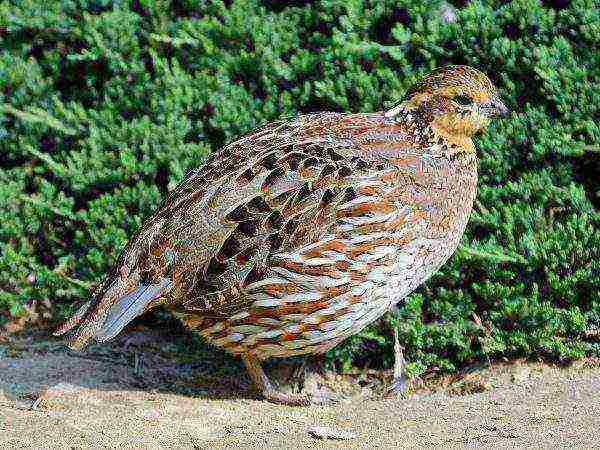
By its nature, an ordinary quail is very shy bird, which in nature is very difficult to notice. Quails grow very quickly, fledge by two weeks. Since that time, young birds have been trying to fly. Quail is one of the migratory birds of the chicken order. Therefore, it is necessary to keep the bird in captivity in cages.
Breeders have bred many breeds of quail, which are bred in a private courtyard in order to obtain meat and eggs. The growth performance of these birds is pretty good. Live male weight home quail ranges from 110 to 180 grams, depending on the breed. Moreover, females of domestic quail are much larger than males. Their weight can reach up to 250 grams. Egg-laying begins early, at 50 days of age. Some breeds start laying a little later. Each female produces more than 300 eggs per year, which are used for culinary purposes and for incubation. The weight of one egg is up to 14 grams.
Quails are grown not only in the country house. In order to obtain good meat carcasses and dietary eggs, quail farms were built. Quail breeding - This is the most cost-effective activity, for a start, you can use a regular barn.
Varieties and their characteristics
Many species of quail have been bred, which conquer breeders with their qualities. Broiler breeds able to provide a large amount of meat at minimal cost. Egg breeds contain mainly for obtaining large eggs, which are in demand in the consumer market.
Texas
This breed of bird was bred to obtain meat... Texas quail outperform other breeds. Broiler type poultry for the creation of which used meat quail breeds.
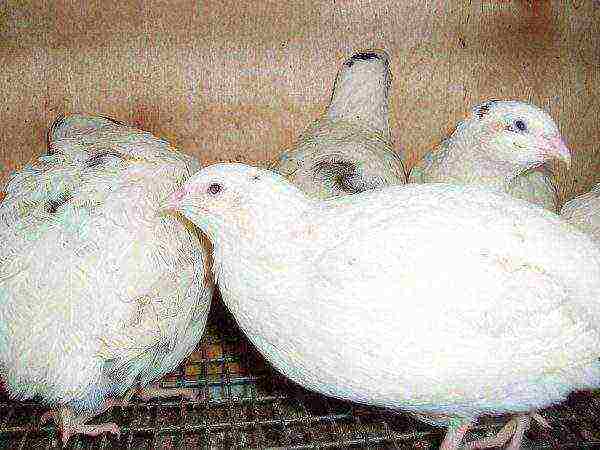
Peculiarities
Texans have a snow-white feather color, for which they are popularly nicknamed albinos or white giants... Sometimes on the white feather of a bird, you can see small black blotches. This is the norm.
Externally, the quail of this breed large... The chest of a pronounced meat type: round, wide. The legs, tail and neck of the bird are short. The tip of the beak is dark, the eyes of the quail are black.
Meat quality
The average bird of this breed produces up to 250 grams of meat. At proper feeding and content, it is capable of gaining up to 550 grams.
Egg production
The first egg in females of this breed, it is formed by the age of two months. The eggs are quite large. In one year, the female is able to lay up to 280 eggs, with an average weight of 12 grams.
Manchurian
Description
Manchu quails are very beautiful birds. Feather color combines feathers of yellow and brown colors. The people call these quails golden. On the breast of the female, you can see characteristic black blotches, which the male does not have.
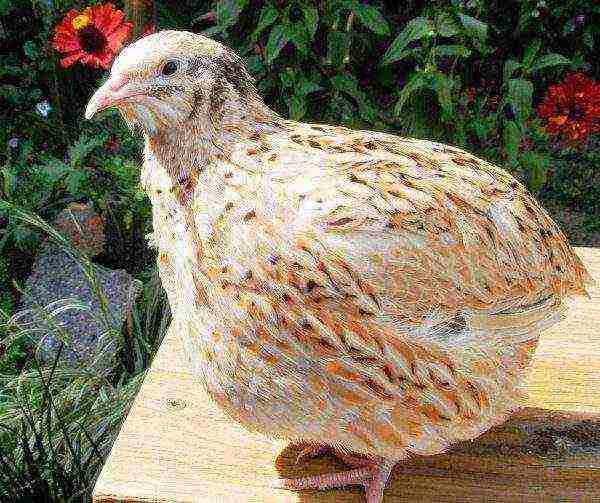
Define sex quail it is possible at 100% only by looking under the tail of the bird. The male has a gland between the tail and the cloaca, and when pressed, a white matter is released. Females do not have this gland.
Bird productivity
The Manchu quail breed is known for its meat and egg qualities... The egg production of females is up to 180 eggs per year, but they are much larger than others. The average egg weight is up to 18 grams.
Males of this breed gain weight 150 grams, but with proper fattening, the birds are capable of giving high rates. Average carcass weight - 300 grams.
Pharaoh meat quail
The main feature of these birds is good meat carcass.
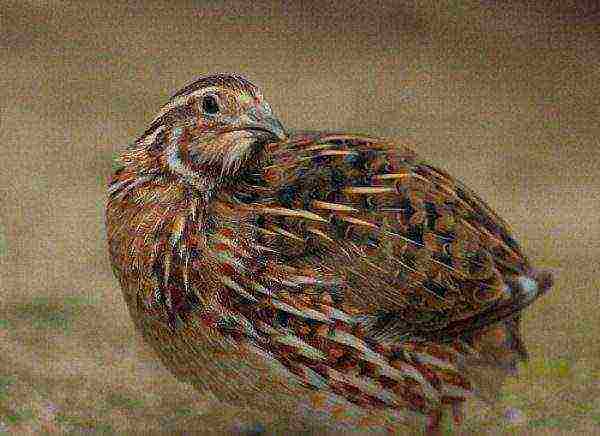
Characteristic
Outwardly, the birds of this breed resemble wild relatives. Plumage color Pharaohs are grayish brown. Females have white and black stripes on the breast. The weight of the females is significantly higher than that of the males.
Meat quality
Pharaohs belong to meat quails. Average female weight reaches 300 grams, and the male is slightly smaller. A distinctive quality of this breed is early maturity... Slaughter can be carried out by two months. Quails of this species need a balanced feed.
Egg-laying
The Pharaoh female begins laying at approximately 45 days. However, the first eggs cannot be used for incubation. Egg weight is up to 15 grams. The average female is able to lay up to 200 eggs in one year of intensive egg-laying. Females must be well fed to produce eggs.
California
California quails are not widely spread and are kept mainly for beauty. Growing these birds is not profitable. Low survival rate of young animals, poor growth performance.
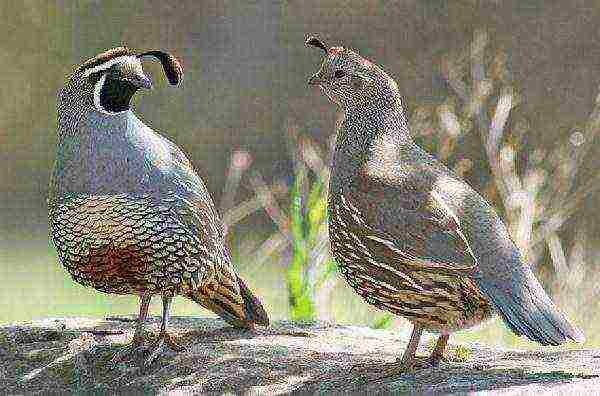
It is necessary to keep this breed in the most natural conditions, otherwise the bird loses its decorative effect.
Japanese
Description
The plumage of the Japanese quail has a rusty brown color... In males, the collar zone is darker than in females.
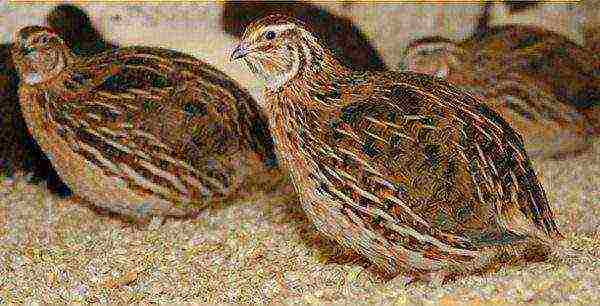
Productive characteristics
Bird weight fluctuates, depending on the breed line. On average, it is up to 150 grams. Egg bird species fly well. Average egg productionfemales make more than 300 eggs per year.
Tuxedo
This breed originated from crossing white and black English quails. Outwardly, a very large beautiful bird.
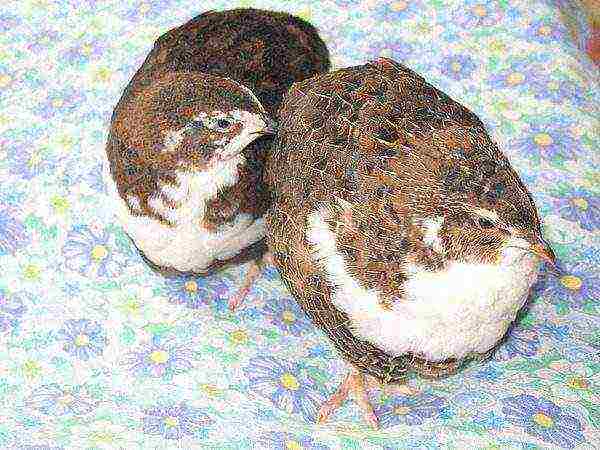
Characteristic
The bird has a tuxedo feather color... On the breast, the feather is light in color, and the back is darker. Females and males of this breed are the same in color.
Productivity
These birds are bred more for decorative purposes. Female weight is only 180 grams, and males do not exceed 150 grams. The bird has good egg production. Tuxedo quail females lay up to 280 eggs per year.
Breeding features
Breeding quails in a summer cottage is quite simple. They do not require a lot of space, high financial costs and are unpretentious in maintenance. All a bird needs is warmth, light and balanced feed. Big advantage quails are eggs that can be eaten even raw. The bird is not affected salmonellosis.
To breed a bird, a breeder needs to decide on the breed and the purpose of quail breeding. All breeds are classified into several types:
- meat quail;
- egg birds;
- meat - egg views.
The last bird species is most in demand. This is due to the fact that in addition to eggs, you can also get good meat.
Incubation of eggs
For quail breeding you will need an incubator. This can be a homemade appliance or a store-bought one. A typical small incubator can hold up to 400 eggs.
Incubation period lasts an average of 17 days. On the 18th day, the incubation ends. If the required temperature is observed, the hatching of the young is very high.
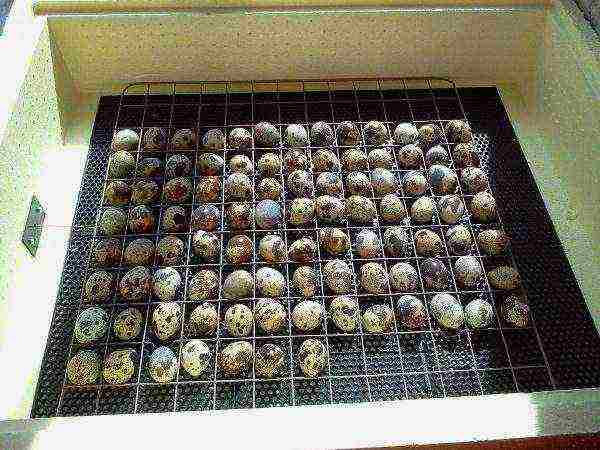
The entire incubation period temperature in the chamber is maintained at a level of 38–38.5 degrees. Air humidity should be more than 50%. Under these conditions, the elimination is amicable and ends after 6 hours.
Raising and caring for chicks
The hatched juveniles are distinguished by their mobility. Contain quail it is necessary in a special brooder, where the required air temperature is maintained. First 14 days the temperature should not fall below 38 degrees.
From day 15 the temperature in the brooder is lowered to 25 degrees. By the age of one month, the chicks should be accustomed to normal room temperature, which is 20-22 degrees.
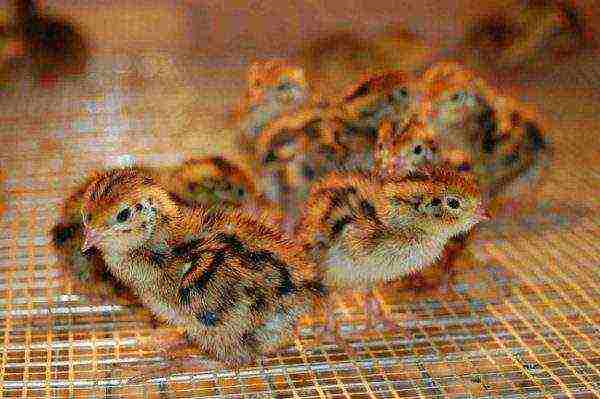
Round the clock light mode support for the first 14 days. Further, the bird is transferred to normal daylight hours.
Feeding quail at home
From the moment of hatching, chicks need vitamins and minerals. You can use quality compound feed for young animals, which contains all the necessary substances. In the absence of food, boiled eggs can be given to the quails, which are crushed and placed in a bowl.
From day 4 small crushed corn grits, cottage cheese and complete feed for young animals are introduced into the feed.
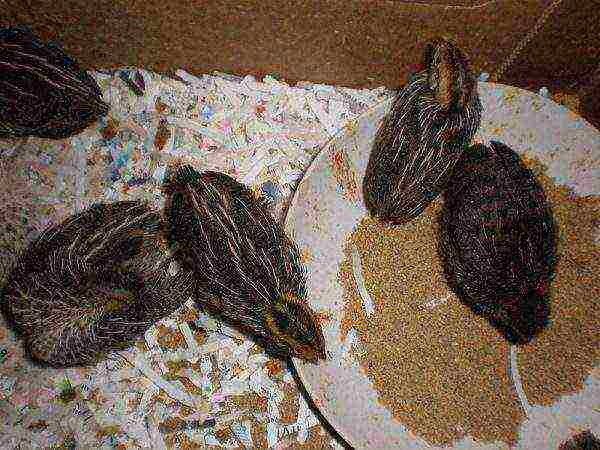
8 to 20 days in the main diet of young animals only compound feed. You can add greens, carrots, meat waste.
From day 20 feeding young quails does not differ from feeding adults.
By week 10 young growth completes and begins puberty... From day 45, most breeds begin egg-laying.
Feeding adult quails
For feeding adults feeders and drinkers taken out of the cage. Birds stick their heads through the bars for feeding. This method of feeding reduces the cost of compound feed.
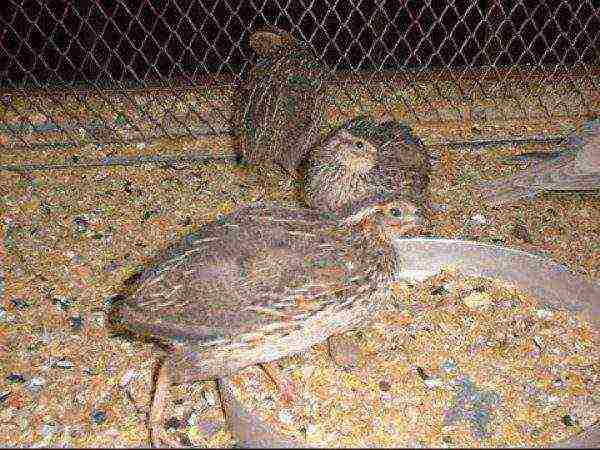
Adult birds fed 3 times a day, while consuming 30 grams of feed per individual.
For females, the best nutrition is balanced feed for laying hens. Sometimes grain, vegetable garden waste, herbs and fruits are added to the feed.The diet of a laying hen must contain crushed shells, chalk, sand, boiled fish.
Feeding birds for meat
When reaching the quails months of age they are separated by gender. Males and rejected females are planted separately and fattened for meat begins.
Fattening is carried out at a temperature of 22 degrees and low light. Feeding mode for these birds is different. Quails are fed 4 times a day, and in large doses. In the first half of the day, green fodder is added, and grain waste is given in the evening. The fattening period is about 60 days.
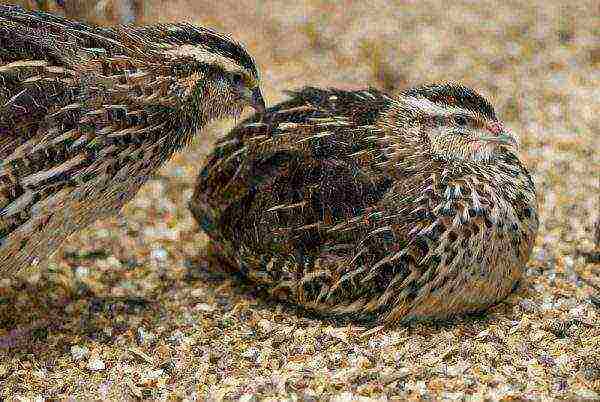
Slaughter is carried out as soon as the bird gains the required body weight. Before slaughter, the quails are not fed for 6 hours. Only water is left in the drinking bowls.
Features of winter cultivation
- Quails are kept in low cells with a mesh floor, which makes cleaning easier and reduces the risk of diseases.
- In winter house temperature should not fall below 16 degrees. With sharp jumps in temperature or when it is too low, the egg production of females drops sharply. The comfortable temperature for the development of the bird should be at 22 degrees.
Quail diseases
Most often, the livestock begins get sick from changing feed, poor living conditions, poor quality feed, lack of nutrients.
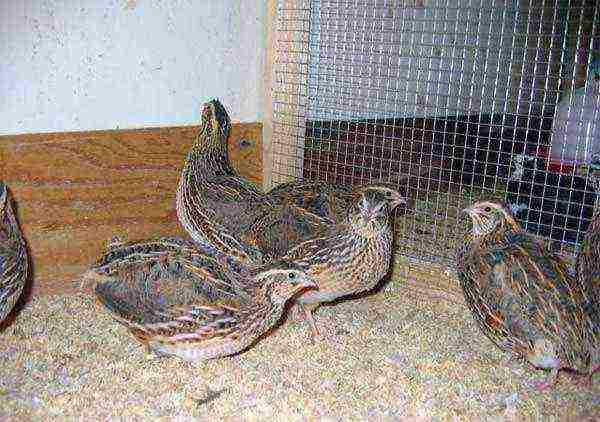
Improper nutrition and maintenance
Quails suffer from vitamin deficiencies, which develop when there is a lack of nutrients or a violation of the diet, a change in feed.
To the symptoms of the disease can be attributed:
- disheveledness feathers;
- loss appetite;
- lethargy;
- overturning heads;
- stretching neck.
Birds change their diet, introduce more nutrients, monitor the feeding regime.
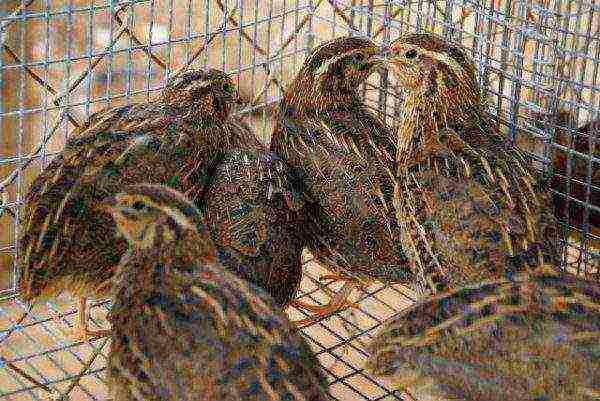
If the conditions for keeping poultry are violated susceptible to the following diseases:
- dropping out oviduct;
- cannibalism;
- dropping out feathers;
It is enough to adjust conditions of detention and the birds are bouncing back. Change the brightness of the lighting, reduce the number of individuals in the cage and introduce missing vitamins and minerals.
Quail reviews from breeders
Many breeders prefer to breed quail Pharaoh and White Texan breeds. Birds grow well, are not prone to pecking, and gain weight well.
Young growth It is distinguished by good vitality, immunity and grows rapidly, so even a novice breeder will not have much difficulty in raising full-fledged individuals.
Breeding quails is no more difficult than chickens. The main task of the breeder - maintenance of cleanliness, observance of conditions of keeping and feeding. With a competent approach to raising quails, birds rush productively and give good growth rates.
